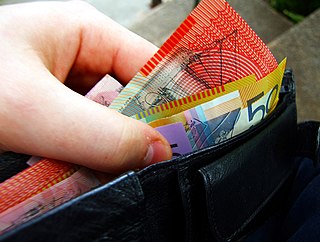
The Australian dollar is the official currency and legal tender of Australia, including all of its external territories, and three independent sovereign Pacific Island states: Kiribati, Nauru, and Tuvalu. As of 2022, it is the sixth most-traded currency in the foreign exchange market and also the seventh most-held reserve currency in global reserves.

The naira is the currency of Nigeria. One naira is divided into 100 kobo.

A banknote—also called a bill, paper money, or simply a note—is a type of negotiable promissory note, made by a bank or other licensed authority, payable to the bearer on demand. Banknotes were originally issued by commercial banks, which were legally required to redeem the notes for legal tender when presented to the chief cashier of the originating bank. These commercial banknotes only traded at face value in the market served by the issuing bank. Commercial banknotes have primarily been replaced by national banknotes issued by central banks or monetary authorities.

The pound sterling is the official currency of the United Kingdom, Jersey, Guernsey, the Isle of Man, British Antarctic Territory, South Georgia and the South Sandwich Islands, and Tristan da Cunha.

The Bank of Scotland plc is a commercial and clearing bank based in Edinburgh, Scotland, and is part of the Lloyds Banking Group. The bank was established by the Parliament of Scotland in 1695 to develop Scotland's trade with other countries, and aimed to create a stable banking system in the Kingdom of Scotland.

Clydesdale Bank is a trading name used by Clydesdale Bank plc for its retail banking operations in Scotland.

The Brunei dollar, has been the currency of the Sultanate of Brunei since 1967. It is normally abbreviated with the dollar sign $, or alternatively B$ to distinguish it from other dollar-denominated currencies. It is divided into 100 sen (Malay) or cents (English). The Brunei dollar is issued by the Brunei Darussalam Central Bank.

The Mauritian rupee is the currency of Mauritius. One rupee is subdivided into 100 cents. Several other currencies are also called rupee.
The Canadian twenty-dollar note is one of the most common banknotes of the Canadian dollar; it is the primary banknote dispensed from Canadian automatic teller machines (ATMs). The newest version, the Frontier Series polymer note, was released to the general public on November 7, 2012, replacing the banknote from the Canadian Journey Series.

Polymer banknotes are banknotes made from a synthetic polymer such as biaxially oriented polypropylene (BOPP). Such notes incorporate many security features not available in paper banknotes, including the use of metameric inks. Polymer banknotes last significantly longer than paper notes, causing a decrease in environmental impact and a reduced cost of production and replacement. Modern polymer banknotes were first developed by the Reserve Bank of Australia (RBA), Commonwealth Scientific and Industrial Research Organisation (CSIRO) and The University of Melbourne. They were first issued as currency in Australia during 1988 ; by 1996, the Australian dollar was switched completely to polymer banknotes. Romania was the first country in Europe to issue a plastic note in 1999 and became the third country after Australia and New Zealand to fully convert to polymer by 2003.

The Canadian fifty-dollar note is one of the most common banknotes of the Canadian dollar. It is sometimes dispensed by ATMs but not as commonly as the $20 note.
Banknotes have been issued for use specifically in Northern Ireland since 1929, and are denominated in pounds sterling. They are legal currencies, but technically not legal tender anywhere. This is not uncommon as most bank notes are not recognised as tender. However, the banknotes are still widely accepted as currency by larger merchants and institutions elsewhere in the United Kingdom. Issuing banks have been granted legal rights to issue currency, and back the notes with deposits at the Bank of England.

Banknotes of the Canadian dollar are the banknotes or bills of Canada, denominated in Canadian dollars. Currently, they are issued in $5, $10, $20, $50, and $100 denominations. All current notes are issued by the Bank of Canada, which released its first series of notes in 1935. The Bank of Canada has contracted the Canadian Bank Note Company to produce the Canadian notes since then. The current series of polymer banknotes were introduced into circulation between November 2011 and November 2013. Banknotes issued in Canada can be viewed at the Bank of Canada Museum in Ottawa.
Note Printing Australia (NPA) is a wholly owned subsidiary of the Reserve Bank of Australia (RBA) that produces banknotes and passports. It was corporatised in July 1998 and is located in Craigieburn, Melbourne. NPA has its origins as a subsidiary of the Commonwealth Bank and was established in 1913 to print banknotes for Australia. After printing paper banknotes for 75 years, NPA introduced the first polymer banknote technology in 1988. NPA print banknotes for several other countries as well as Australia due to the high standards of durability and difficulty of counterfeiting.

The Australian twenty-dollar note was issued when the currency was changed from the Australian pound to the Australian dollar on 14 February 1966. It replaced the £10 note which had similar orange colouration. There have been only three different issues of this denomination: a paper note which had a gradient of yellow and red, with a distinct orange background, and two designs of polymer note which can be recognised for their distinct red-orange colouration. The first polymer note was issued on 31 October 1994 and the Next Generation polymer banknote was issued on 9 October 2019.

The Australian ten-dollar note was one of the four original decimal banknotes excluding the Australian five-dollar note, was issued when the currency was changed from the Australian pound to the Australian dollar on 14 February 1966. It replaced the Australian five-pound note, which included the same blue colouration. There have been four different issues of this denomination: a paper banknote; a commemorative hi-polymer note, to celebrate the bicentennial of Australian settlement ; the 1993–2017 polymer note; and from September 2017 a polymer note featuring a transparent window.
The notes of the Australian dollar were first issued by the Reserve Bank of Australia on 14 February 1966, when Australia changed to decimal currency and replaced the pound with the dollar. This currency was a lot easier for calculating compared to the previous Australian pound worth 20 shillings or 240 pence.
Banknotes of Scotland are the banknotes of the pound sterling that are issued by three Scottish retail banks and in circulation in Scotland. The issuing of banknotes by retail banks in Scotland is subject to the Banking Act 2009, which repealed all earlier legislation under which banknote issuance was regulated, and the Scottish and Northern Ireland Banknote Regulations 2009. Currently, three retail banks are allowed to print notes for circulation in Scotland: Bank of Scotland, Royal Bank of Scotland, and Clydesdale Bank.

The Frontier series is the seventh series of banknotes of the Canadian dollar released by the Bank of Canada, first circulated in 2011. The polymer banknotes were designed for increased durability and to incorporate more security features over the preceding 2001 Canadian Journey series. The notes feature images that focus on historic Canadian achievements and innovation. Printed on polymer, the 2011 Frontier series was the first series issued by the Bank of Canada printed on a material other than paper. The 2011 Frontier series was followed by the 2018 series.

Northern Bank Limited is a retail bank in Northern Ireland. Northern Banking Company Limited was formed from a private bank, with the Deed of Partnership being signed on 1 August 1824. It is one of the oldest banks in Ireland with its private banking history dating back to 1809, and forms part of one of the Big Four banks in Ireland. Northern Bank took on the name of its parent company Danske Bank as its trading name in November 2012. It is a leading bank in Northern Ireland and a growing bank in Great Britain. In Northern Ireland, the Bank issues its own banknotes.













